Recently, Sandy and I spent a couple of weeks on board a cruise ship with a lovely couple, Gerry and Marsha. They were our evening dinner mates along with two other wonderful couples. It turns out Gerry got his undergraduate degree in archeology (he’s a federal judge—kind of like me getting my degree in geology but becoming a commercial banker). So needless to say, we had some interesting conversations.
With that in mind, I thought I’d dedicate a blog on Paris archeology to Gerry. So Gerry, this one’s for you.
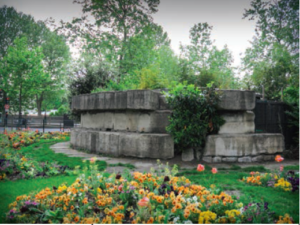
I think I’ve written in the past that I’m convinced the largest museum in the world is just beneath the surface of Paris streets (if you don’t believe me, visit the Crypte Archéologique du Parvis Notre-Dame—the Archaeological Crypt). It seems every time an excavation is performed, they find something interesting from the Middle Ages. The problem is the Paris government doesn’t like to do archeological digs. It’s only when a basement is remodeled, a new Métro station is created, or restoration is done on one of Paris’s landmarks that we get a glimpse into Paris’s past.
316 Complete Skeletons
One of the most recent finds (January 2015) was a medieval cemetery with its occupants thought to either be victims of the plague or folks who died in a nearby hospital. This was found when the owners of the Monoprix supermarket decided to completely remodel the basement of their store located on the corner of Rue Réaumur and the Boulevard de Sébastopol (2e).
I don’t know what the status is but you might want to try and visit it. On the ground floor of the supermarket is the hair accessories department. Nearby is a door marked “Staff Only.” Push the door open and descend into the basement via the circular steel staircase. Let me know what you find.
Palais du Louvre (Palace of the Louvre)
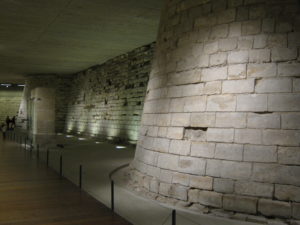
Several of the most interesting excavations (or should I say the results) were the ones performed in 1866, 1984, and 1985 in the Cour Carrée of the Louvre Museum. During these excavations, the foundations of the original Louvre Palace, including the keep called the Grosse Tour (the Big Tower) were uncovered.
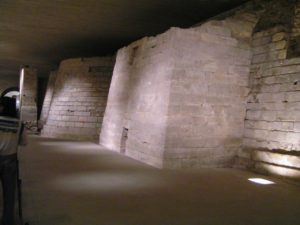
King Philippe II Augustus began the building of the palace in 1180. By the time Philippe had completed his wall around the Right Bank, the palace stood outside the wall. The palace was designed as a fortress since the king speculated that the city was more vulnerable to attacks from the north and northwest. During the 16th-century, the palace began to give way to the buildings we see today. In other words, the kings began to demolish it stone by stone.
When you visit the Louvre, begin your tour in the basement. There you will see the original walls, foundations of the four corner towers, and the Grosse Tour. You’ll even see the stone cutter’s “graffiti” on some of the walls. This kind of stuff is fascinating to folks like Gerry and myself.
The Bastille
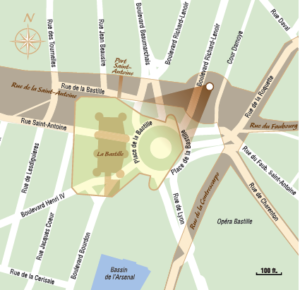
While we all know the Bastille and its role in the French Revolution, it is a fact that by the time of the Revolution, the fortress/prison was not used much (only seven prisoners were released on 14 July 1789). King Louis VI was going to tear it down but didn’t have time—he lost his head.
The Bastille was originally built by King Charles VI as a fortress to protect the Saint-Antoine Porte, a major entrance to the city from the east. Over time, it was converted to a prison. It primarily held persons of the nobility who were imprisoned under the dreaded lettre de cachet—a document signed by the king authorizing the imprisonment of a person without any due course of law.
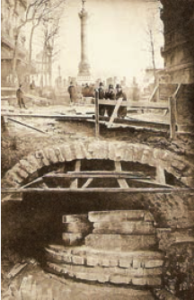
During the Métro station excavation in 1899, the foundations of the Liberty Tower were found—one of the eight towers of the Bastille. The stones were removed and today, you can see them at the little park called Square Henri Galli next to the Seine. The Pont (i.e., bridge) de la Concorde was built with stones from the Bastille. However, as the bridge was expanded, the original stones were covered up so that the only way to see them today is to look straight up as you go under the bridge on a boat—remember that when you take the river tour boat ride.
London’s Roman Amphitheater
Sandy and I took a private walking tour of the old Londinium several years ago. Today, it’s the City of London but back then, it was the Roman walled city. Our guide took us to this big open square surrounded by large government buildings. On the pavement was a huge arc outlined by red bricks. It was the outline of where the old Roman amphitheater once stood. Well, not quite.
We went into one of the buildings and walked down four flights of stairs until we walked through a nondescript door (i.e., no signage). All of a sudden, we were standing in the middle of the ruins of the amphitheater. Believe it or not, running water was still being pumped through the original Roman piping.
Arènes de Lutèce
Just so I can whet your appetite for my new book, I’ll take you to an actual Roman amphitheater in Paris. Not too many tourists know it is the oldest Paris monument let alone that it even exists. You will see the cages where the animals and Christians were held prior to entering the ring to die.
So you can see that every city has its own subterranean secrets.
New Books

 Today’s blog describes several locations where I will take you in the next two books: Where Did They Burn the Last Grand Master of the Knights Templar? – Volumes One and Two: Jacques de Molay’s Curse and The Royal Crypts, respectively. We are about ready to go to print on Volume One while Volume Two will be available in early 2018.
Today’s blog describes several locations where I will take you in the next two books: Where Did They Burn the Last Grand Master of the Knights Templar? – Volumes One and Two: Jacques de Molay’s Curse and The Royal Crypts, respectively. We are about ready to go to print on Volume One while Volume Two will be available in early 2018.
I’m excited to get back to work on the next series of walking tour books covering the Nazi occupation of Paris between 1940 and 1944. Over the foreseeable future, I will devote some of the blogs to sites that were significant during the Occupation of Paris. I hope you enjoy the abbreviated stories and perhaps they may spark an interest in my new book (coming soon).
WHERE DID THEY PUT THE GESTAPO HEADQUARTERS? A WALKING TOUR OF NAZI OCCUPIED PARIS (1940–1944)
Someone Is Commenting On Our Blogs
Peter S. requested we make a connection through LinkedIn. He came across our blogs (stewross.com) and was impressed enough to reach out to me. Peter is a Senior Lecturer at the University of New South Wales in Sydney, Australia. He is a historian and expert on World War II. Peter is fluent in four languages and the author of six books on the American combat experience in the European and Pacific theaters of war, military cemeteries, the fate of civilians in the front lines, relations between liberators and the liberated, and the Battle of the Bulge. I’ve invited Peter to do a guest blog for us and I hope he’ll consider doing one in the future. Thank you Peter for your kind words.
If there is a topic you’d like to see a blog written about, please don’t hesitate to contact me. I love hearing from you so keep those comments coming.
What’s New With Sandy and Stew?
As previously mentioned, Volume One of the new book, Where Did They Burn the Last Grand Master of the Knights Templar? will be going to press in the next few days. By the way, I’ll take you the Archeological Crypt in one of the books. I hope you enjoy that stop along with all the others.
Share This:
Follow Stew:
Find Stew’s books on Amazon and iBooks.
Please note that we do not and will not take compensation from individuals or companies mentioned or promoted in the blogs.
Walks Through History
Copyright © 2016 Stew Ross


I wish Paris was excavated more. It is fascinating what lies behind a busy, modern city. When I visit, I always begin by la Cite. Musee de Cluny is my favorite. I recently read the whole area is being renovated.
Hi Daniella;
You and I are similar in our starting point and interest in the Cluny. I wish more excavating was done too. But the city government is absolutely adverse to archeological digs. Have you been down to the excavations on the island? It is at the original level of the river. It’s fascinating and most people either don’t care or they don’t know it’s there. The entrance is very nondescript. Talk soon. STEW